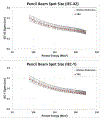Semi-automated IGRT QA using a cone-shaped scintillator screen detector for proton pencil beam scanning treatments
- PMID: 30736026
- PMCID: PMC7448303
- DOI: 10.1088/1361-6560/ab056d
Semi-automated IGRT QA using a cone-shaped scintillator screen detector for proton pencil beam scanning treatments
Abstract
To promote accurate image-guided radiotherapy (IGRT) for a proton pencil beam scanning (PBS) system, a new quality assurance (QA) procedure employing a cone-shaped scintillator detector has been developed for multiple QA tasks in a semi-automatic manner. The cone-shaped scintillator detector (XRV-124, Logos Systems, CA) is sensitive to both x-ray and proton beams. It records scintillation on the cone surface as a 2D image, from which the geometry of the radiation field that enters and exits the cone can be extracted. Utilizing this feature, QA parameters that are essential to PBS IGRT treatment were measured and analyzed. The first applications provided coincidence checks of laser, imaging and radiation isocenters, and dependencies on gantry angle and beam energies. The analysis of the Winston-Lutz test was made available by combining the centricity measurements of the x-ray beam and the pencil beam. The accuracy of the gantry angle was validated against console readings provided by the digital encoder and an agreement of less than 0.2° was found. The accuracy of the position measurement was assessed with a robotic patient positioning system (PPS) and an agreement of less than 0.5 mm was obtained. The centricity of the two onboard x-ray imaging systems agreed well with that from the routinely used Digital Imaging Positioning System (DIPS), up to a consistent small shift of (-0.5 mm, 0.0 mm, -0.3 mm). The pencil beam spot size, in terms of σ of Gaussian fitting, agreed within 0.2 mm for most energies when compared to the conventional measurements by a 2D ion-chamber array (MatriXX-PT, IBA Dosimetry, Belgium). The cone-shaped scintillator system showed advantages in making multi-purpose measurements with a single setup. The in-house algorithms were successfully implemented to measure and analyze key QA parameters in a semi-automatic manner. This study presents an alternative and more efficient approach for IGRT QA for PBS and potentially for linear accelerators.
Figures







References
-
- Bissonnette JP et al. 2012. Quality assurance for image-guided radiation therapy utilizing CT-based technologies: A report of the AAPM TG-179 Med. Phys 39(4) 1946–1963 - PubMed
-
- Bujold A, Craig T, Jaffray D and Dawson L 2012. Image-guided radiotherapy: Has it influenced patient outcomes? Semin. Radiat. Oncol 22 50–61 - PubMed
-
- Dhanesar S et al. 2013. Quality assurance of proton beams using a multilayer ionization chamber system Med. Phys 40(9) 092102. - PubMed
-
- Kooy HM et al. 2010. A case study in proton pencil-beam scanning delivery Int. J. Radiat. Oncol. Biol. Phys 76(2) 624–630 - PubMed
Publication types
MeSH terms
Grants and funding
LinkOut - more resources
Full Text Sources
